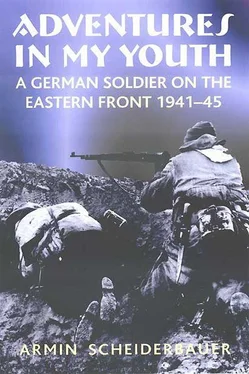At a window of her apartment in the Peterstrasse stood Gisela. She came to the station. The company was already entrained, and we were able to speak for a while together. Not only for her but also for me, that farewell was hard. She gave me a book Wer Gottes Fahrt gewagt , ‘Who dares God’s journey’. It had pictures and histories from the house of Flex, at its centre Walter Flex, the poet of the Jugendbewegung or youth movement, who was killed in action in 1918. I stood with Gisela a little apart from the others. There was a fence between us. She was wearing a bright summer dress with a narrow waist. Gisela’s eyes shone moist and we kissed tenderly. To the strains of muss i denn the train began to move. Gisela’s face and figure became blurred to me. Soon I could only see the white speck of her dress and finally even that disappeared. The dedication that she had written in the book read: ‘For lonely hours in the field – from my heart – your Gisela’.
On 6 June we were sitting in the goods station at Lodz, which at that time was called Litzmannstadt. News reached us of the landing of Allied troops in France. Even if we ordinary Landser did not know anything of the wider picture, it was still clear to everyone that by then the war had entered into a decisive stage. However, that it could end with a German defeat was far from anyone’s thoughts. In the ‘travelling community’ of the goods wagon we were temporarily filled with a feeling of special belonging. Once we arrived out there the companionship of the train would be immediately torn apart and we would be assigned to many different units. But at that moment everyone felt the common experience of an unknown, even if distant, danger. After some excited commentary on the news it became quiet and one man hummed a tune. Then one became several and finally every one joined in the familiar old melody:
So take my hands and lead me,
To my blessed end and eternally!
I cannot go alone, not one step,
where you will go and stay, take me with you.
When the last verse rang out, the modest beginning had grown into a choir. It was impressive how many men knew the words for the second and third verses.
On 11 June we were at our destination. The journey had passed through Warsaw, Vilna, Dünaburg, Molodetschno and Polotzk, as far as a Vitebsk, and finished in Lowsha. The command post of the Division was located there. The allocation of men took place as expected. The Majority of the infantrymen joined the newly reformed third Grenadierregiment of the Division. By then it consisted of regiments 7, 461, and 472. I became Adjutant of the 2nd Battalion, which was commanded by Hauptmann Muller. ‘Pi’ Muller had been among the seven ‘seveners’ who had been convalescing in Freiwaldau. When he found out that I had come on that transport, he asked for me as adjutant. Our 252nd Infanteriedivision , the Eichenlaub or ‘Oak leaf’ Division, was the division located at the point of connection between army groups Centre and North. That meant particular danger, because a preferred target for attack was at those points of connection, where areas of command were separated.
The enemy knew that there it would be harder to re-establish connections once they had been broken than it would within a single area of command. The Russian summer offensive was imminent. We were greeted with that announcement. So for formation and training, for getting to know one’s way about, there only remained days, or at most weeks. On 15 June the Füsilier battalion under Major von Garn, deployed in the main line of resistance, had succeeded in shooting down a Russian reconnaissance aircraft. Its passengers had been general staff officers, who wanted to view from as close as possible the terrain over which their troops would attack.
The battalion was welded together ‘in a flash’, so to speak. The work as adjutant was exciting and reconciled me with the fact that for the time being I could not be with my Regiment 7. I was responsible for the preparation of battalion orders, correspondence and personnel matters. But above all, the fact that I was leader of the battalion staff with the orderly officer, the signals staff and the runners, was a new experience for me.
On 18 June an exercise involving the whole battalion took place, in which Hauptmann Muller and I participated on our horses. My Army-issue horse, the white horse Hans, was a wilful chap. It was difficult to keep him within the prescribed distance of half a horse’s length behind the commander’s horse. He had also well and truly stripped me of a waist belt against a wall. In order not to get trapped by my left leg, I had to jump off at the last moment. With that battalion exercise, my life as a ‘cavalryman’, so to speak, came to an end. From then on there was no more opportunity for riding. On 20 June the battalion was moved up to the village of Lowsha along the Vitebsk-Polozk railway line. Then there was no more doubt that the Russians would begin their offensive on 22 June, the third anniversary of the beginning of that campaign. On the evening of the 21st the commander, Hauptmann Muller, invited all his officers to celebrate the start of their new posts. For many, it would at the same time be a farewell.
I quote from the history of Grenadierregiment 7, by Romuald Bergner: ‘The most serious defeat ever inflicted on the German Wehrmacht in the Second World War began on 22 June 1944, as the Red Army began the battle in White Russia’. The fact that the beginning of the operation coincided with the third anniversary of Barbarossa was no coincidence. The date had been deliberately set by the Soviet high command. That reminder of Russia’s darkest hour was intended to inflame the passions of the soldiers of the Red Army and to inspire all the soldiers of the Red Army to give of their utmost. According to the final plan, Bagration , the Red Army was to begin large-scale offensives, following rapidly in succession, in six different sectors. That almost simultaneous large-scale offensive, in six widely separated locations, was intended to split the German defences, to splinter their forces, and to deny them the opportunity of deploying all available troops in a concerted effort to repulse the Soviet attacks.
The historian Andreas Hillgruber has shown that a direct causal connection exists between the collapse of Army Group Centre and the downfall of the Third Reich. On 22 June 1944 the Soviet general attack began against the front of Army Group Centre. In pincer operations the feste Platze of Vitebsk, Orsha, Mogilew, and Bobruisk were encircled. The mass of the Soviet offensive forces, however, struck out further westwards. The catastrophe took its course. In purely numerical terms it had almost twice the impact as that of Stalingrad. The operational effects were a great deal worse.
To the north of Vitebsk, where we were, the Soviets began their offensive in the early morning of 22 June. On a front extending 64 kilometres, the IX Army Corps with Corps Detachment D and the 252nd Infantry Division were conducting the defence. There, eight divisions of the Soviet 43rd Army attacked. To those were soon added the first division of the 6th Guards Army. It was intended to achieve a breakthrough some 25 kilometres wide. Along with the offensive divisions of the Red Army there rolled two armoured brigades into the focal-point of the breakthrough area. The two offensive wedges encountered the right-hand and central sectors of the 252nd Infantry Division. In the course of the night of 21 June and in the early hours of 22 June, the Russians pushed up nearer and nearer to our position. At 4am the enemy’s heavy barrage began and at 4.20am they attacked on a wide front. Breakthroughs were made in the sector of the 1st Battalion Grenadierregiment 7 and the Division’s Füsilier battalion.
Читать дальше












